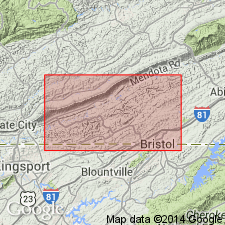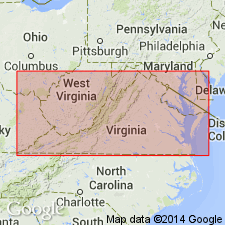
- Usage in publication:
-
- Little Valley limestone*
- Modifications:
-
- Named
- Dominant lithology:
-
- Limestone
- Sandstone
- AAPG geologic province:
-
- Appalachian basin
Summary:
Named the Little Valley limestone for Little Valley, Scott Co., VA. Consists of an upper dark-colored unit 100 to 150 feet thick that is generally divided into two parts by beds of argillaceous limestone, and a lower argillaceous and fossiliferous limestone unit approximately 500 feet thick that contains two distinct zones of sandstone. Unit overlies the Maccrady shale and underlies the St. Louis limestone. The Little Valley is of Late Mississippian age.
Source: GNU records (USGS DDS-6; Reston GNULEX).

- Usage in publication:
-
- Little Valley Limestone Member
- Modifications:
-
- Revised
- AAPG geologic province:
-
- Appalachian basin
Summary:
In this report the Greenbrier Limestone is divided into (ascending) Little Valley Limestone Member, St. Louis Limestone Member (or Hillsdale Member of Reger, 1926), "St. Genevieve" Limestone Member, and Gasper Limestone Member. The Little Valley is described here as a medium-gray shale and argillaceous limestone with interbedded sandstone. A gray, locally dolomitic, thin- to medium-bedded limestone, locally containing anhydrite, ranging from a few ft to 60 ft in thickness, outcrops at the base. Disconformably overlies the Maccrady Shale or Price Formation. Contains abundant fossils of Late Mississippian (Meramecian) age.
Source: GNU records (USGS DDS-6; Reston GNULEX).
For more information, please contact Nancy Stamm, Geologic Names Committee Secretary.
Asterisk (*) indicates published by U.S. Geological Survey authors.
"No current usage" (†) implies that a name has been abandoned or has fallen into disuse. Former usage and, if known, replacement name given in parentheses ( ).
Slash (/) indicates name conflicts with nomenclatural guidelines (CSN, 1933; ACSN, 1961, 1970; NACSN, 1983, 2005, 2021). May be explained within brackets ([ ]).

